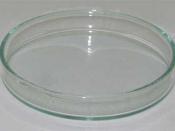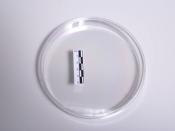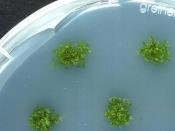Investigating the effects of acid rain in the growth of cress seedlings IntroductionAcid rain is rain or any other form of precipitation, which is unusually acidic. It has harmful effects on plants, animals and buildings. Acid rain is mostly caused by human emissions of sulphur and nitrogen compounds which react in the atmosphere to produce acids.
Acid rain can slow the growth of vulnerable forests and cause leaves and needles to turn brown and fall off. In addition, it depletes minerals from the soil and then it stunts the growth of the plant. Some of the most dramatic effects on forests have been observed in Europe. In 1983, a survey in West Germany showed that 34 % of the country's total forest is damaged by air pollution. This included about one half of the famous Black Forest. Switzerland has recorded damage to 14 % of its forest trees.
In this experiment, I will find out what consequences acid rain has on the germination and subsequent growth of cress seedlings.
I will use cress seedlings, which germinate quickly and can grow a few centimetres in a matter of days and sodium metabisulphite, which reacts slowly with water to produce sulphur dioxide gas. The seedlings will have to be in an enclosed system so the sulphur dioxide does not escape. The experiment is a simulation trying to model a powerstation producing sulphuric acid, falling on the seedlings as acid.
Research QuestionHow do different concentrations of acid rain affect the growth rate of cress seedlings?HypothesisI predict that the stronger the concentration of the acid the fewer seeds will germinate and the less they will grow because acid rain has very harmful effects on plants, damaging the leaves, removing water from the waxy cuticle and limiting the nutrients available.
VariablesIndependent variable (to manipulate, alter) ÃÂ Concentrations of sodium metabisulphite, pHDependant variable (measurements) ÃÂ Change in the height of the stem of the cress seedlingsControlled variable (to keep constant) ÃÂ The light, oxygen and temperature that the seedlings will be exposed to, the length of time the seeds were left on the window cillApparatus- 6 Petri dishes- 6 discs of cotton wool- 60 cress seedlings grown for four days in the sunlight- Sodium metabisulphite solutions: weak and strong- Distilled water- Small measuring cylinder- Ruler- Universal indicator paper- Transparent plastic bagProcedure1. Place a piece cotton wool disc in each Petri dish.
2. Place 20 cress seedlings equally in each Petri dish, on the cotton wool.
3. Pour 7cm3 of distilled water in all three.
4. Place them in the window cill.
5. Three days later, record heights of stems and pH.
6. Transfer the cotton wool containing the seedlings to each new Petri dish.
7. Pour 7cm3 of water in a separate Petri dish and label it ÃÂcontrolÃÂ.
8. Pour 7cm3 of strong sodium metabisulphite solution in another Petri dish and label it ÃÂstrongÃÂ.
9. Pour 7cm3 of weak sodium metabisulphite solution in another Petri dish and label it ÃÂweakÃÂ.
10. Place these three Petri dishes alongside a Petri dish containing seedlings and place everything inside a transparent plastic container.
11. Place the sealed plastic bags in a well-lit area of the laboratory where they will be exposed to the same light intensity and temperature.
12. Check the seedlings one week after and record observations (condition, colour), heights of stem and pH once more.
ResultspH:StrongWeakControlBeforeAfter6.5Height of stem:Strong Acid (+/- 1ml)Weak Acid (+/- 1ml)Control (+/- 1ml)Without acidic solutionAfter acidic solutionWithout acidic solutionAfter acidic solutionWithout acidic solutionAfter acidic solution10,41,60,91,20,53,420,62,00,20,90,95,230,31,70,43,31,65,140,92,30,83,21,15,450,92,31,41,61,25,561,22,60,53,72,86,770,92,30,42,62,36,080,11,00,33,52,46,790,72,10,11,01,84,8101,02,20,21,11,25,5110,62,00,71,61,05,3120,92,30,42,33,06,5131,32,71,23,01,86,1140,51,90,51,50,32,5150,72,10,30,91,76,0161,12,51,12,01,65,9171,93,31,42,73,16,2180,20,60,61,11,05,3190,21,60,71,51,65,9200,71,11,01,73,27,2Average0,82,00,72,01,75,6Change1,21,33.9Conclusion and EvaluationAfter completing this experiment, I immediately found that my Hypothesis proved true. The control grew an average of 5,6m (after acidic solution) whilst the two experimentals staggered at 2,4 and 2,0.
The experiment should prove that acid rain does stunt germination and in some cases prevents it completely. In addition, it also affects the growth of seedlings dramatically. The pH level of 6.5 in the control proves more feasible for growth. There was also some wilderness in the stems of the seeds tested with the sodium metabisulphite solution.
The biggest growth recorded was of 4,4cm in seed 13 in Control. The smallest growth recorded was of 0,4 cm in seed 18 in Strong.
Criticism and Suggestion for Improvement- Distribution of the seeds, could be spread out more equally- More seeds needed in order to increase the accuracy of the experiment- Repetition of the experiment to increase the accuracy of the results- If the variables were controlled the accuracy of the results would increase- The room temperature kept changing each day, which altered the circumstances under which the investigation was carried outExtension of Experiment- Seedlings could be grown elsewhere, on the soil for example, which would give a more genuine and reliable account.
- I wonder what would happen to germination when using a stronger acid level. I also wonder what would happen if a researcher were to record data for a lot longer than just the germination stage. What would happen to its growth as the plant grew and became mature in an acidic environment?


